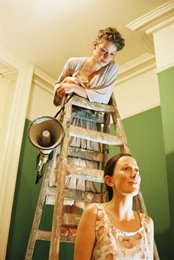Intimacy is the defining feature of the experience of outlandishtheatre co.’s the living room. In a tiny space at the Pearse Centre (three rows of seats, one row of cushions down in front), the audience faces the dividing doors that open out into a ‘living room’ (read: place for living) where Bernie O’Reilly and Maud Hendricks enact an emotionally intense and multi-layered drama.
Mother (Hendricks) and Daughter (O’Reilly) exist on (at least) two planes: one where daughter has just become engaged to a man of whom other does not approve, and one where they inhabit roles in a retelling of the European folk nightmare of 'Bluebeard'. This latter is a nightly ritual, beginning at midnight and proceeding to morning. But tonight is different. Perhaps to mark the occasion of her daughter’s engagement, or perhaps to try to hammer home the lesson more forcefully, Mother is allowing Daughter to play the role of the wife-to-be in the tale of matrimonial murder while taking the role of narrator and Bluebeard herself. Props and costumes are arranged and the performance begins, with slippage in and out of ‘reality’.
The programme notes (by Hendricks) for the living room feature a list of inspirations that includes Clarissa Finkola Estes, Angela Carter, Shakespeare and classical myth. It’s a heady taxonomy of reference points guiding the audience towards a particular set of contextual frames. Much of it is self-evident, of course. There’s not a lot of ambiguity in the deployment of primal archetypes of Mother and Daughter, or in the interlocking of the struggles in ‘fantasy’ and ‘reality’ (such as they are in what is a clearly symbolic space to begin with). Lines like mother’s dire assessment of the suitor (or is it Bluebeard) that “His eyes and his stories don’t match up” work both ‘in’ and ‘out’ of character in both realms of meaning, and the very specific direction towards a change in the status quo (the daughter has changed roles in the drama) invites us to read the myth as literally ‘living’.
 Sound artist Slavek Kwi is given collaborative credit here, and the production is certainly infused with both live and recorded noise creating a soundscape beyond the confines of the visual space. Miscellaneous birdsong, ominous humming, bells, drums, creaking metal and other discordant assonances permeate the enclosed space. Gabriel Peelo’s lighting is also vital though, providing narrative and emotional cues that shift the audience in and out of the various story realms, sometimes draining the life from O’Reilly’s skin, sometimes bathing Hendricks in sinister hues – all befitting the moment.
Sound artist Slavek Kwi is given collaborative credit here, and the production is certainly infused with both live and recorded noise creating a soundscape beyond the confines of the visual space. Miscellaneous birdsong, ominous humming, bells, drums, creaking metal and other discordant assonances permeate the enclosed space. Gabriel Peelo’s lighting is also vital though, providing narrative and emotional cues that shift the audience in and out of the various story realms, sometimes draining the life from O’Reilly’s skin, sometimes bathing Hendricks in sinister hues – all befitting the moment.
Sarah Jane Scaife directs at the behest of Hendricks and O’Reilly, invited into what is a clearly defined artist collaboration. One senses that perhaps much of the business around the use of props (particularly a prominent ladder) was talked out from performance concepts, and certainly Hendricks makes great use of said ladder to stretch her body like a coiling serpent. The inherent conceptual core is so dense here that the job of direction really seems to have been simply about technical clarity. The website for outlandishtheatre co. features a rather charming cut-out animation blocking the show, and I must admit to being slightly disappointed it didn’t somehow feature.
the living room is clearly operating within a very specific set of registers and will appeal primarily to those for whom these registers have emotional meaning. Although to me it seemed cold and overly schematic, my companion felt less excluded, and certainly on a basic technical level, the show could be recommended if the description suggests something to which you as a patron might feel intimately connected.
Dr. Harvey O'Brien teaches at the UCD O'Kane Centre for Film Studies, University College Dublin.